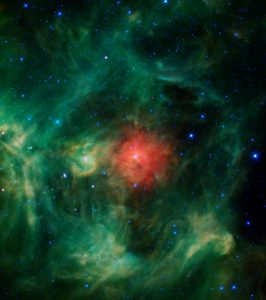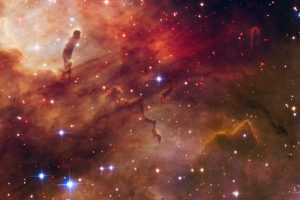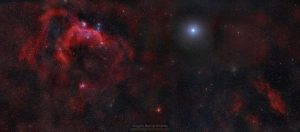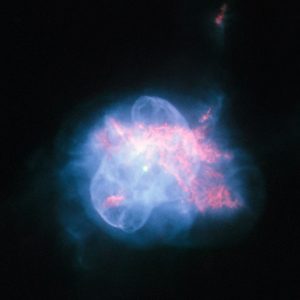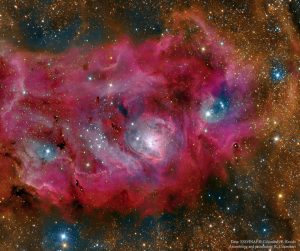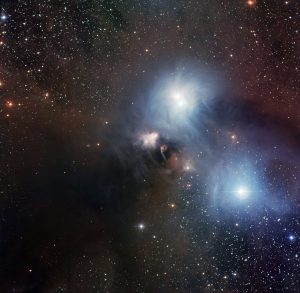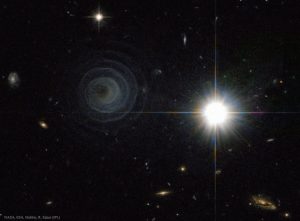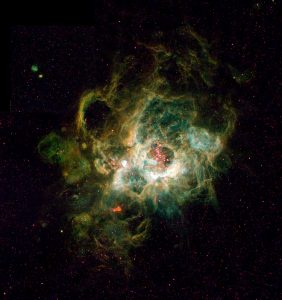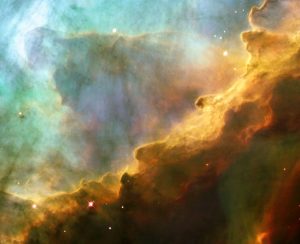nebulosa
Una Ghirlanda in Cielo
In perfetto spirito natalizio questa spettacolare nebulosa ripresa dal telescopio WISE della NASA ha l’aspetto allegro ed elegante di una festosa ghirlanda, ornata di un bel nastro rosso, sempreverde e lucine d’argento. Il nome ufficiale è Barnard 3 o IRAS G159.6-18.5, ma è stata soprannominata in modo appropriato, Nebulosa Ghirlanda. Nubi come questa sono nursery stellari, regioni in cui nascono nuove stelle. Continua a leggere
La Nebulosa Crescente
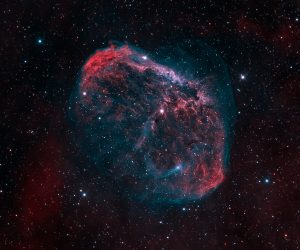 La Nebulosa Crescente, NGC 6888, è una straordinaria bolla cosmica ampia circa 25 anni luce, soffiata dai venti della brillante stella massiccia centrale. Continua a leggere
La Nebulosa Crescente, NGC 6888, è una straordinaria bolla cosmica ampia circa 25 anni luce, soffiata dai venti della brillante stella massiccia centrale. Continua a leggere
Una Nidiata di Stelle Bambine
Questa splendida ripresa del telescopio Hubble mette in evidenza una parte delle nubi che circondano la famosa immagine dell’ammasso Westerlund 2, che contiene alcune delle stelle più calde, luminose e massicce conosciute, nella costellazione della Carena. Gli astri brillanti riversano torrenti di luce ultravioletta e intensi venti di particelle cariche che spazzano e scavano l’avvolgente nube di idrogeno gassoso. Continua a leggere
Sirio e il Gabbiano
Questa ampia, spettacolare immagine si estende in cielo per quasi 20 gradi. La regione interessata è ricca di nebulosità e si trova vicino al confine della superbolla di Orione-Eridano, densa di gusci di gas e polveri incastonati nelle nubi molecolari vicino al piano della Via Lattea. Continua a leggere
NGC 6210: Una Delicata Bolla Blu
Questa straordinaria e curiosa nebulosa planetaria, NGC 6210, si trova a circa 6500 anni luce di distanza, nella costellazione di Ercole. È stata scoperta nel 1825 dall’astronomo tedesco Friedrich Georg Wilhelm Struve . Continua a leggere
La Nebulosa Laguna in Alta Definizione
Le stelle combattono gas e polveri nella Nebulosa Laguna ma vincono… gli astrofotografi. Nota anche come M8, questa fotogenica e spettacolare nebulosa è visibile anche ad occhio nudo in direzione della costellazione del Sagittario. Continua a leggere
Un Acquerello Cosmico
Questa magnifica visione della regione attorno alla stella R Coronae Australis è stata realizzata con immagini riprese con il Wide Field Imager (WFI) all’Osservatorio dell’ESO. R Coronae Australis si trova nel cuore di una vicina regione di formazione stellare ed è circondata da una nebulosa a riflessione di una delicata tonalità bluastra avvolta in una vasta nube di polveri. Continua a leggere
La Straordinaria Spirale in LL Pegasi
Cosa ha generato la straordinaria formazione a spirale visibile nell’immagine a sinistra? Nessuno può affermarlo con certezza, sebbene probabilmente questa strepitosa struttura sia in relazione ad una stella parte di un sistema binario, che sta iniziando la fase di nebulosa planetaria, con conseguente espulsione degli strati esterni della sua atmosfera. Continua a leggere
Un fuoco d’artificio di nascita stellare
Questa festosa nebulosa colorata è una delle più vaste regioni di formazione stellare in una galassia vicina. NGC 604 è simile alle regioni di nascita stellare nella nostra galassia, come la familiare Nebulosa di Orione, ma è di gran lunga più estesa, quasi 1.500 anni luce, e contiene molti più astri di recente formazione. Continua a leggere
La Tempesta Perfetta
Come la furia di un mare in tempesta, questa immagine del telescopio Hubble mostra un oceano ribollente di gas nella massiccia e luminosa nebulosa molecolare Messier 17. L’immagine riprende solo una piccola regione all’interno di Messier 17, una culla dove nascono stelle. Conosciuta anche come Nebulosa Omega, o Nebulosa Cigno, è localizzata a circa 5500 anni luce dalla Terra nella costellazione del Sagittario. Continua a leggere
